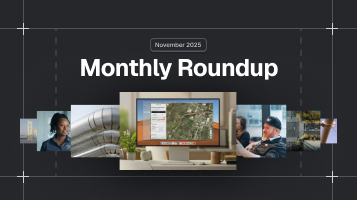Why Real-Time Utility Data is A Game-Changer in Construction Project Planning
Written by

Published on
February 12, 2024


Table of contents
When you're managing a construction or infrastructure project, early access to utility data is crucial.
And today, you need that data faster than ever before. With billions of dollars in funding for infrastructure development flowing from state and federal governments and huge backlogs of repair and maintenance projects in many areas, projects must proceed quickly and efficiently in order to meet the demand.
But there's a workforce problem: the Bureau of Labor Statistics cites a deficit of nearly one million engineers, with an additional annual demand for 25,000 new civil engineers to manage and execute existing infrastructure projects.
Between the high demand for infrastructure development and the shortage of skilled workers, conventional practices like manual utility record research and utility coordination are no longer sustainable. Our industry has a serious capacity problem that only digitization can solve.
Traditional methods often involve lengthy turnaround times and validation processes, slowing down project planning and making it harder to win bids.
Why is it critical to have real-time utility data at the early stages of the project?
Utility data plays a critical role in the early stages of construction planning, providing valuable information about the location and condition of underground utilities such as water, gas, and electricity lines. This data is essential for conducting feasibility studies and scoping projects in order to assess the project's risk.
With real-time utility data in the early stages of the project lifecycle, you could:
- Keep projects on budget with lower contingency
- Minimize change orders
- Reduce utility strikes
With utility data in hand, before the project begins, project managers (PMs) and civil engineers would be prepared to make more informed decisions. They could assess potential risks and plan accordingly, helping to avoid costly surprises and keep projects on track.
Challenges in Utility Data Acquisition
As a PM, civil engineer, or utility coordinator, you typically have to rely on as-builts, manual surveys, public records, calling 811, or doing field investigations as sources of information.
Finding what you need might involve digging through paper records in a town hall basement, playing phone tag with utility owners, or driving to a project site to investigate.
Even if you can find what you need, it's likely to take some time and effort — and the data might be incomplete, nonexistent, or inaccurate. Often, it's necessary to compare several sources of information to verify accuracy.
Or you might spend hours making calls and digging through local records only to find out the data you need doesn't exist, and you'll have to do your own (expensive) field investigation.
The downsides of traditional methods for gathering utility data include:
- Time delays: Extended turnaround times for utility data create delays in project pursuits and bidding — leading to missed opportunities.
- Competitive disadvantage: Waiting for utility data puts you at a disadvantage when bidding against competitors. Those with quicker access to utility data gain a significant edge in the bidding process.
- Cost escalation: Delays in obtaining data can lead to unforeseen utility-related challenges, causing budget overruns and impacting project profitability and feasibility.
The need for speed: Quick decision-making in construction
In the fast-paced world of construction, agility in decision-making is crucial. PMs and civil engineers need to be able to make quick and informed decisions during the scoping phase.
But when it takes days — or weeks — to get the utility data you need, the consequences can be costly.
For example, let's say you're preparing to bid on a project. Without access to utility data, you're unaware of several water and gas lines that will need to be relocated to complete the project — hidden obstacles that will cause cost overruns.
When you bid without having good information, you end up with headaches, costly delays, change orders, and redesigns after construction has already begun.
Benefits of preliminary real-time utility data
Imagine having near-instant access to current utility data. Armed with real-time information, you could:
- Scope projects faster. Instead of spending hours on the phone or in the car seeking utility data, get immediate data access to finish and submit the bid.
- Make more informed decisions. When you have the data you need in the planning phase, you'll avoid costly surprises, such as utility strikes.
- View aggregated utility data. Get a comprehensive overview of utility infrastructure in your project area.
- Win more bids. With better information, you can create more targeted project plans — outpacing your competition.
Let's say you want to bid on a potential project. You pull up utility data remotely on a digital platform, scope the project, and run a feasibility study to get your bid in faster — giving you an edge over the competition.
Access to preliminary real-time utility data would help you make project planning more efficient, minimize risks, and reduce costs in the long term.
The future of construction planning
As time goes on and new tools emerge, technology will play an increasing role in mitigating risk during the earliest, most cost-effective stages of construction.
Solutions like Utilility AI Mapping, which utilizes AI to collect, organize, analyze, and conflate thousands of public and private utility records into a unified map, will help construction PMs and utility coordinators get the comprehensive data they need faster.
And with new data collection methods, such as the use of drones and remote sensing technologies, obtaining utility data will become even easier and more reliable.
Powering fast decision-making
In today's fast-paced, competitive landscape, gaining early access to utility data is not just advantageous—it's crucial for success. This is especially true with the high demand for infrastructure projects and the shortage skilled labor.
Traditional methods of obtaining utility data are outdated and time-consuming, leading to delays, increased costs, and missed opportunities.
On a recent episode of the InfraTalk America podcast, Federal Highway Administrator Shailen Bhatt said, "[We see] a desire to deliver projects in a more innovative fashion — but it's also a critical need. We can't build projects in the 21st century like we did in the 20th century. It's a different world out there."
With access to preliminary real-time utility data, you could overcome these capacity challenges with instant utility insights, enabling you to accelerate planning & field team mobilization and achieve a competitive advantage to secure more bids.
Recent blog posts

Our Newsletter
Join 7k infrastructure professionals
Get monthly insights on ways to build smarter, faster and safer with Utility AI.



.avif)




